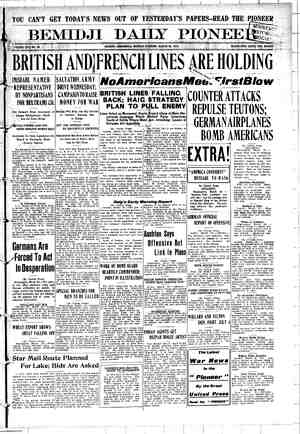The Nonpartisan Leader Newspaper, March 25, 1918, Page 11
You have reached the hourly page view limit. Unlock higher limit to our entire archive!
Subscribers enjoy higher page view limit, downloads, and exclusive features.
CPRTIRN. (apar A AT - RN AEY R S Y = . L <=<z-4pms, . which the millers got free from * wheat growers of the Northwest sus-. ) _...and the. grain .combine. The; millers ‘ are cnabled to degrade the wheat from - Millers Sell. Wild Peas at HEN grain grading hearings f| were being held in the North- west by the United States de- partment of agriculture, millers made the flat statement that there was no successful way of separating wild peas from wheat. Grain buyers - who penalize farmers for wild peas - - denied they were used as a cover crop in the South, - or were marketable to any extent, even if they could be separated from the wheat. - The Nonpartisan Leader has secured documen- - <fary.-evidence completely disproving both of these ~“statements of millers andgrain buyers. .The Leader has 18 certificates of the state weighmaster of Minnesota, showing 18 cars of wild peas, ranging in weight from 82,880 pounds to 96, 000 pounds, shipped during the months of October, November and December, 1917, and January, 1918, from ONE ELEVATOR of the Washburn mills at Minneapolis. ' One of the certifi- cates ‘is reproduced herewith. ' These 18-cars of wild peas contained a total of 1,143,220 pounds, or 5,716 ~farmers and for which farmers were =penalized by having their grain lower- ed in grade. G The value of 5,716 tons of wild peas taken from the wheat, at $40 per ton, is $228,640, an absolute loss to the farmers of the Northwest at this ONE ELEVATOR ALONE. - - . But this is not the only loss that the tain by reason of the present grades’ - two to four grades on account df the presence of wild peas. ‘This.'means', not be,rgmoyed‘m_m\w!lent WHEN THE NEW DRIVER This is a reproduction of an official certificate of -of 13 carloads worth ov. a further loss averaging between 10 to 15 cents per bushel, wherever the wild peas are numerous. In the wild pea sections this robbery of the . farmers has reached enormous proportions. The Lafayette Farmers’ elevator, at Lafayette, Minn., during the last year, its manager states, handled just one car of No. 3 wheat. Everything else was™ No. 4 or lower, the degrading being principally on account of the presence of wild peas, which do not " damage the wheat and which millers take_ out and scll at fancy prices. ~ Contradicting flatly the statement that the wild pea is not used as a cover crop in the South, C. P. Bull, professor in agronomy at the University of F162P NF 02 s HtS CERTIFIES T THAT THERE WAS WEIGHED UNDER THE TAKES HOLD OF THE REINS fl o ’fi' —Drawn expressly for the Leader by W. C. Morris a Big Price Minnesota, states in a letter to L. W. Samuelson of the Nonpartisan league: >~ “The people of Georgia use this vetch for cover crops in their orchards. The first information ir connection with this use of the veteh was intimatec in their request for two carloads a year ago, bul at that time I was unable to find any of the seec available.” The N. L. Willett Seed company of Augusta, Ga. has written Professor Bull two letters inquiring about the wild pea seed. This company will be ir the market for more wild peas next year. The Nonpartisan Leader has copies of these letters o file at its office, completely refuting the clain that there is no market for wild peas in the South OFFICIAL CERTIFICATE ¥l OF STATE WEIGHT out FEB 251918 49 b 17 m’”fl G.H.TUNELL, CHIEF INSPECTOR ST. PAUL, MINN. 'PAGE: ELEVEN : SEE.OTHER SIDE = A S L T the state weighmaster of Minnesota, showing a car of wild peas, yer $200,000; sold by one elevator in Minnesota. Yet millers and grain buyers say wild peas and that there is no market for them if they could be. Y ] RSN B LIS / ) ~ 5 ‘






